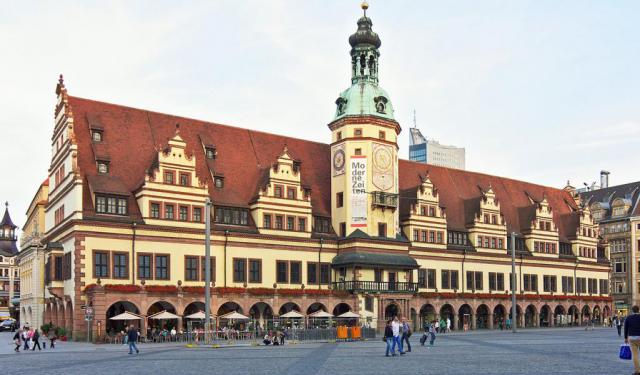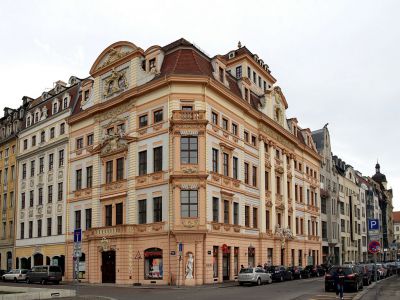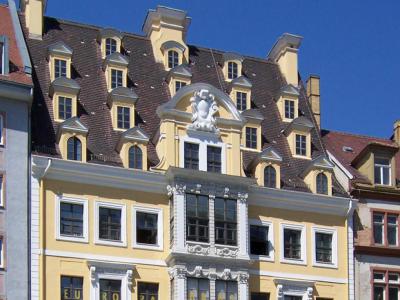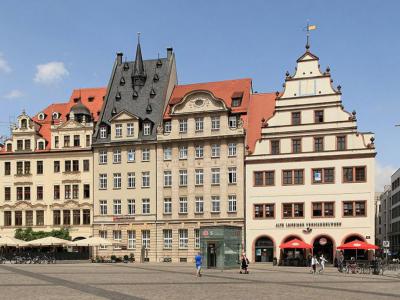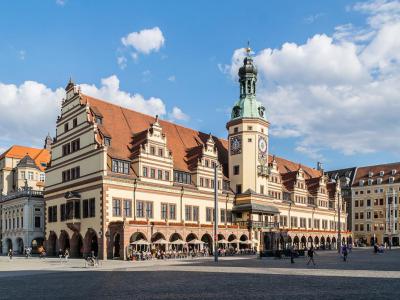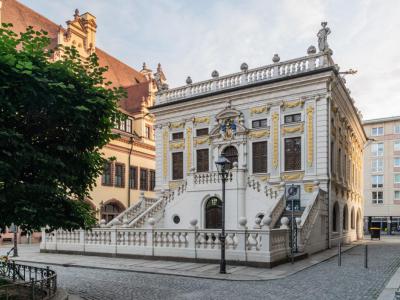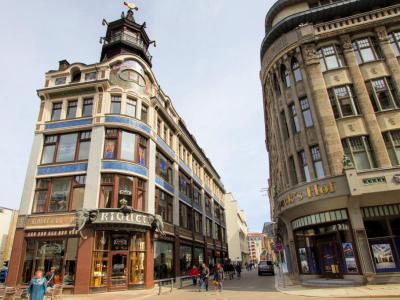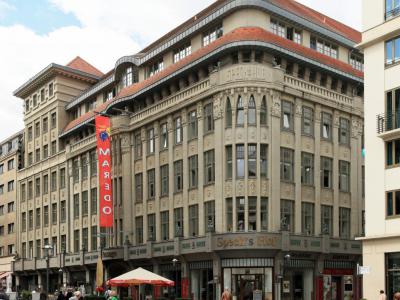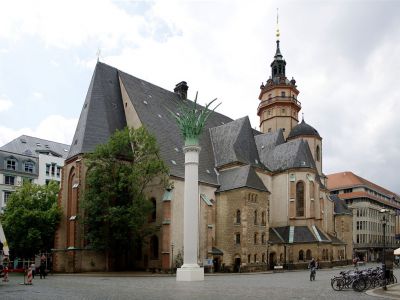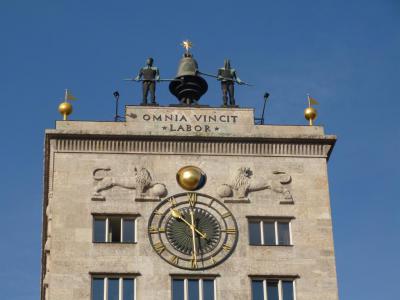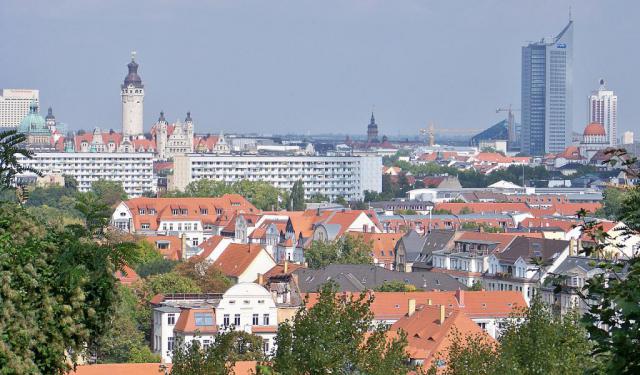Leipzig Architectural Jewels (Self Guided), Leipzig
Anyone who has ever wanted to delve into Leipzig's history could hardly imagine doing so without exploring the local array of architectural jewels. Indeed, Leipzig boasts one of Germany's most beautiful collections of Renaissance buildings.
Our first point of interest lies in downtown Leipzig at the intersection of Katherine and Bruhl Streets. Here, the stunning Baroque-style Romanus House preserves its historical charm with intricate details such as ornate ledges, bay windows, garlands, and a statue of Hermes.
Further down Katherine Street, the Free House (Fregehaus) serves as a reminder of Leipzig's prosperous merchant history, showcasing a symmetrical main façade adorned with a bay window embellished with fruit garlands, alongside dormer windows on its steeply inclined roof, and other baroque elements.
Walking on brings us to the Old Scale House (Alte Waage), an elegant Renaissance building that once served as a weigh station for goods entering the city.
From there, we reach Market Square and the Old Town Hall – the iconic symbols of Leipzig's civic life, with their impressive facades and bustling atmosphere.
Nearby, the Old Stock Exchange (Alte Handelsbörse) exudes grandeur and opulence, reflecting Leipzig's role as a major trading hub in Europe.
Meanwhile, Riquet House, Speck's Yard (Specks Hof), and Saint Nicholas Church (Nikolaikirche) each contribute to Leipzig's architectural tapestry with their unique styles and historical significance.
Finally, the Kroch-Hochhaus, a more modern high-rise building, stands in stark contrast to Leipzig's historic architecture, yet it represents the city's ongoing evolution and embrace of contemporary design.
Visiting Leipzig's architectural wonders offers a glimpse into its past, present, and even future. Each of these buildings tells a story of the city's enduring legacy and cultural importance. To experience the charm and beauty of Leipzig's architecture firsthand, take this self-guided walk. Leipzig awaits, ready to captivate and inspire!
Our first point of interest lies in downtown Leipzig at the intersection of Katherine and Bruhl Streets. Here, the stunning Baroque-style Romanus House preserves its historical charm with intricate details such as ornate ledges, bay windows, garlands, and a statue of Hermes.
Further down Katherine Street, the Free House (Fregehaus) serves as a reminder of Leipzig's prosperous merchant history, showcasing a symmetrical main façade adorned with a bay window embellished with fruit garlands, alongside dormer windows on its steeply inclined roof, and other baroque elements.
Walking on brings us to the Old Scale House (Alte Waage), an elegant Renaissance building that once served as a weigh station for goods entering the city.
From there, we reach Market Square and the Old Town Hall – the iconic symbols of Leipzig's civic life, with their impressive facades and bustling atmosphere.
Nearby, the Old Stock Exchange (Alte Handelsbörse) exudes grandeur and opulence, reflecting Leipzig's role as a major trading hub in Europe.
Meanwhile, Riquet House, Speck's Yard (Specks Hof), and Saint Nicholas Church (Nikolaikirche) each contribute to Leipzig's architectural tapestry with their unique styles and historical significance.
Finally, the Kroch-Hochhaus, a more modern high-rise building, stands in stark contrast to Leipzig's historic architecture, yet it represents the city's ongoing evolution and embrace of contemporary design.
Visiting Leipzig's architectural wonders offers a glimpse into its past, present, and even future. Each of these buildings tells a story of the city's enduring legacy and cultural importance. To experience the charm and beauty of Leipzig's architecture firsthand, take this self-guided walk. Leipzig awaits, ready to captivate and inspire!
How it works: Download the app "GPSmyCity: Walks in 1K+ Cities" from Apple App Store or Google Play Store to your mobile phone or tablet. The app turns your mobile device into a personal tour guide and its built-in GPS navigation functions guide you from one tour stop to next. The app works offline, so no data plan is needed when traveling abroad.
Leipzig Architectural Jewels Map
Guide Name: Leipzig Architectural Jewels
Guide Location: Germany » Leipzig (See other walking tours in Leipzig)
Guide Type: Self-guided Walking Tour (Sightseeing)
# of Attractions: 9
Tour Duration: 1 Hour(s)
Travel Distance: 0.9 Km or 0.6 Miles
Author: karenl
Sight(s) Featured in This Guide:
Guide Location: Germany » Leipzig (See other walking tours in Leipzig)
Guide Type: Self-guided Walking Tour (Sightseeing)
# of Attractions: 9
Tour Duration: 1 Hour(s)
Travel Distance: 0.9 Km or 0.6 Miles
Author: karenl
Sight(s) Featured in This Guide:
- Romanus House
- Fregehaus (Frege House)
- Alte Waage (Old Scale House)
- Market Square and Old Town Hall
- Alte Handelsbörse (Old Stock Exchange)
- Riquet House
- Specks Hof (Speck's Yard)
- Nikolaikirche (St. Nicholas Church)
- Kroch-Hochhaus (Kroch High-Rise)
1) Romanus House
Romanus House is a historical edifice in downtown Leipzig on the corner of Katherine and Bruhl Streets. This beautiful Baroque-style house, reminiscent of old Dresden architecture, today serves as a commercial building. The house covers four city plots of land and is mounted on a plinth-like ground floor.
There are three main stories above the ground floor and another short story under the mansard roof. The North facade has 13 window axes, overlooking Bruhl Street. The East facade has six axes facing Katherine Street. The corner of the house is beveled at a 45-degree angle with bay windows.
The facades have ornate ledges. The tall gable on the north side has an oval window. The East facade has a small gable with two kidney-shaped windows. Garlands adorn the sills, entrances, and ceilings. A statue of Hermes by sculptor Balthasar Permoser poses in the ground floor corner niche.
Romanus House got its name after the former Mayor of Leipzig. Franz Conrad Romanus was the mayor in 1701. He commissioned the building to be designed by the council mason, Johann Gregor Fuchs.
The Romanus House changed hands many times, finally being owned by contractor Jurgen Schneider in the 1990s.
There are three main stories above the ground floor and another short story under the mansard roof. The North facade has 13 window axes, overlooking Bruhl Street. The East facade has six axes facing Katherine Street. The corner of the house is beveled at a 45-degree angle with bay windows.
The facades have ornate ledges. The tall gable on the north side has an oval window. The East facade has a small gable with two kidney-shaped windows. Garlands adorn the sills, entrances, and ceilings. A statue of Hermes by sculptor Balthasar Permoser poses in the ground floor corner niche.
Romanus House got its name after the former Mayor of Leipzig. Franz Conrad Romanus was the mayor in 1701. He commissioned the building to be designed by the council mason, Johann Gregor Fuchs.
The Romanus House changed hands many times, finally being owned by contractor Jurgen Schneider in the 1990s.
2) Fregehaus (Frege House)
The Frege House (Fregehaus), one of Leipzig’s most striking and historically rich buildings, stands proudly in the city center as a testament to Renaissance and Baroque architectural mastery. Originally built around 1535, this four-winged structure was transformed into its current Baroque form between 1706 and 1707 by Johann Gregor Fuchs, a renowned Leipzig master builder, for the merchant Gottfried Otto. The renovation included the addition of a symmetrical main façade adorned with a decorative bay window and 16 dormer windows arranged in four rows on the steep, 62-degree inclined roof. Despite the Baroque modifications, elements of the original Renaissance style remain, such as the cross vault of the courtyard entrance and portals on the ground floor.
In 1782, the house was purchased by Christian Gottlob Frege II, a prominent banker who established his trading and banking house on the premises. The Frege family’s banking business operated from the Frege House until 1945, and commercial activities, with state involvement, continued until 1976. The building's historical significance is underscored by its notable visitors, including Johann Wolfgang von Goethe and other dignitaries from German princely houses.
From 1978, the Frege House served as the headquarters for the VEB Leipzig Monument Preservation, which undertook extensive renovations from 1980 to 1986. Today, it stands as a beautifully preserved example of Baroque architecture, rich with Leipzig’s commercial and cultural heritage.
In 1782, the house was purchased by Christian Gottlob Frege II, a prominent banker who established his trading and banking house on the premises. The Frege family’s banking business operated from the Frege House until 1945, and commercial activities, with state involvement, continued until 1976. The building's historical significance is underscored by its notable visitors, including Johann Wolfgang von Goethe and other dignitaries from German princely houses.
From 1978, the Frege House served as the headquarters for the VEB Leipzig Monument Preservation, which undertook extensive renovations from 1980 to 1986. Today, it stands as a beautifully preserved example of Baroque architecture, rich with Leipzig’s commercial and cultural heritage.
3) Alte Waage (Old Scale House)
On the north side of Leipzig's Market Square on the corner of Katherine Street is Old Scale House (Alte Waage). The Council Scales (Rats Waage) was the core of the Leipzig Trade Fair in the 16th century. All goods had to be weighed here. A duty was collected to be shared by the city and the king.
The Scale House was constructed in 1555, as directed by the Mayor of Leipzig, Hieronymus Lotter. It was built in the Renaissance style by master builder Paul Speck. The front had a four-tiered voluted gable and a sundial. Below this was a stair tower. There were two upper floors, above the basement ground floor and attic floors. The basement held the council bar and a drinking room.
The Old Scale House became a commercial building. From 1590, the house was the seat of the Leipzig Council Post with the messenger room. The post office was housed here from 1661 to 1712. Weighings were transferred to a new location in 1820. In 1861, during renovations, the stair tower was removed. The building was destroyed in the air raid of December 1943 and was undeveloped for a few years.
In 1964 the Scale House was built anew as designed by Leipzig architect Wolfgang Muller. The entire structure, including the Katherine Street side facade, is new. Only the south side gable was fashioned in the Renaissance style.
The Scale House was constructed in 1555, as directed by the Mayor of Leipzig, Hieronymus Lotter. It was built in the Renaissance style by master builder Paul Speck. The front had a four-tiered voluted gable and a sundial. Below this was a stair tower. There were two upper floors, above the basement ground floor and attic floors. The basement held the council bar and a drinking room.
The Old Scale House became a commercial building. From 1590, the house was the seat of the Leipzig Council Post with the messenger room. The post office was housed here from 1661 to 1712. Weighings were transferred to a new location in 1820. In 1861, during renovations, the stair tower was removed. The building was destroyed in the air raid of December 1943 and was undeveloped for a few years.
In 1964 the Scale House was built anew as designed by Leipzig architect Wolfgang Muller. The entire structure, including the Katherine Street side facade, is new. Only the south side gable was fashioned in the Renaissance style.
4) Market Square and Old Town Hall (must see)
The Market Square of Leipzig is the central place of Leigzip's city center. There are arcades and courtyards well worth a visit, and the Old Town Hall housing the City History Museum is the central attraction. Saint Nicholas and Saint Thomas Churches are easily reached from here.
Throughout the year, the square is the venue of a diversity of Markets and events. There is the Easter Market, the Wine Festival, Leipzig Market Music, and the fabulous Christmas Market. Since the 13th century, Leipzig and its Markets have been the most vital centers of trade in Germany.
In 1341, Frederick II, Son of Frederick the Peaceful and Margrave of Meissen, offered the cloth merchants of Leipzig a Romanesque building of their own at the south end of the Leipzig Market Square. This building, called the Cloth Hall (Tuchhaus), shared extensions and spaces with the City Council.
The building complex grew. Two structures were added in the 15th century. A council chamber was completed in 1467. A stair tower emerged in 1476. In 1498, after all the growth and extensions, it was decided to rebuild the Town Hall.
The Old Town Hall was rebuilt in its current Saxon Renaissance style in 1557. It housed the Upper Court and the Court of Aldermen, the city magistrate, council archives, and prison cells. In 1905, it was decided to use the Old Town Hall as the Leipzig City History Museum.
The two-story building is over 300 feet long. It has a steep roof with 13 connecting row dormers and staggered gables. A stone arcade faces the square. An octagonal stair tower is next to the main entrance. The entrance is flanked by two ionic columns topped with the gaff heads of the master builders. Stone box oriels are on the gable ends.
In the large ceremonial hall is a portrait of Johann Sebastian Bach by German painter Elias Gottlob Haussmann. Haussmann also signed Bach's employment certificate as a cantor at Saint Thomas' Church. There is also a scale model of the city in 1832 made by Leipzig upholsterer and furniture maker Johann Christoph Merzdorf.
Throughout the year, the square is the venue of a diversity of Markets and events. There is the Easter Market, the Wine Festival, Leipzig Market Music, and the fabulous Christmas Market. Since the 13th century, Leipzig and its Markets have been the most vital centers of trade in Germany.
In 1341, Frederick II, Son of Frederick the Peaceful and Margrave of Meissen, offered the cloth merchants of Leipzig a Romanesque building of their own at the south end of the Leipzig Market Square. This building, called the Cloth Hall (Tuchhaus), shared extensions and spaces with the City Council.
The building complex grew. Two structures were added in the 15th century. A council chamber was completed in 1467. A stair tower emerged in 1476. In 1498, after all the growth and extensions, it was decided to rebuild the Town Hall.
The Old Town Hall was rebuilt in its current Saxon Renaissance style in 1557. It housed the Upper Court and the Court of Aldermen, the city magistrate, council archives, and prison cells. In 1905, it was decided to use the Old Town Hall as the Leipzig City History Museum.
The two-story building is over 300 feet long. It has a steep roof with 13 connecting row dormers and staggered gables. A stone arcade faces the square. An octagonal stair tower is next to the main entrance. The entrance is flanked by two ionic columns topped with the gaff heads of the master builders. Stone box oriels are on the gable ends.
In the large ceremonial hall is a portrait of Johann Sebastian Bach by German painter Elias Gottlob Haussmann. Haussmann also signed Bach's employment certificate as a cantor at Saint Thomas' Church. There is also a scale model of the city in 1832 made by Leipzig upholsterer and furniture maker Johann Christoph Merzdorf.
5) Alte Handelsbörse (Old Stock Exchange)
The Old Stock Exchange (Alte Handelsbörse or Alte Börse) in Leipzig stands as the city's oldest assembly building for merchants and its oldest Baroque structure. Constructed in 1678 as the Börse, it was conceived as a neutral venue for merchants to conduct business, an initiative driven by 30 prominent local merchants in response to concerns raised by foreign traders. The city council approved the construction on May 6, 1678, and the building likely owes its design to Johann Georg Starcke, a master builder from the court of John George II, Elector of Saxony.
Located at the Naschmarkt, adjacent to the Old Town Hall, the Börse's construction commenced on May 30, 1678, and was operational by 1679, although interior decorations were not finalized until 1687. The ground floor housed merchant offices, while the upper floor featured the Börsensaal, a hall used for auctions, balls, and various other events.
The building suffered severe damage during the Second World War, burning down completely in 1943 and losing its valuable stucco ceiling and ceiling paintings. A temporary roof was installed to secure the structure. Restoration of the exterior began in 1955 and was completed in 1962, and since then, the Old Stock Exchange has hosted cultural events, including readings, concerts, and exhibitions. Between 1992 and 1995, the building underwent extensive renovation, focusing on restoring the original facade colors and 17th-century-style window glazing, further preserving its historical essence as a cherished event venue.
Located at the Naschmarkt, adjacent to the Old Town Hall, the Börse's construction commenced on May 30, 1678, and was operational by 1679, although interior decorations were not finalized until 1687. The ground floor housed merchant offices, while the upper floor featured the Börsensaal, a hall used for auctions, balls, and various other events.
The building suffered severe damage during the Second World War, burning down completely in 1943 and losing its valuable stucco ceiling and ceiling paintings. A temporary roof was installed to secure the structure. Restoration of the exterior began in 1955 and was completed in 1962, and since then, the Old Stock Exchange has hosted cultural events, including readings, concerts, and exhibitions. Between 1992 and 1995, the building underwent extensive renovation, focusing on restoring the original facade colors and 17th-century-style window glazing, further preserving its historical essence as a cherished event venue.
6) Riquet House
Riquet House, also known as the “House with the Elephants,” is a striking example of architectural fusion, blending Art Nouveau with oriental influences. Located in Leipzig, this historic building was constructed between 1908 and 1909 for Riquet & Company, an oriental trading company that imported goods from China and Japan. The architect, Paul Lange, designed the building with a nod to the company’s trading roots, incorporating elements of East Asian architecture such as a pagoda-like roof and a colorful façade.
One of the most distinctive features of Riquet House is the two copper-plated elephant heads flanking the entrance, a symbol of the company and a popular photo spot for visitors. The building’s interior, now beautifully restored, retains its historic charm, with spacious high-ceilinged rooms, granite pillars, and intricate Art Nouveau details that blend seamlessly with the oriental design.
Today, Riquet House serves as a café, restaurant, and wine cellar, offering a unique dining experience steeped in history. It is one of the few remaining coffeehouses in Leipzig’s city center, aiming to revive the city’s café tradition with specialties like the Leipziger Lerche, Kaffee Riquet, and the Pharisäer. The café’s historical ambiance, combined with its distinctive architectural style, makes it a must-visit spot for both locals and tourists.
One of the most distinctive features of Riquet House is the two copper-plated elephant heads flanking the entrance, a symbol of the company and a popular photo spot for visitors. The building’s interior, now beautifully restored, retains its historic charm, with spacious high-ceilinged rooms, granite pillars, and intricate Art Nouveau details that blend seamlessly with the oriental design.
Today, Riquet House serves as a café, restaurant, and wine cellar, offering a unique dining experience steeped in history. It is one of the few remaining coffeehouses in Leipzig’s city center, aiming to revive the city’s café tradition with specialties like the Leipziger Lerche, Kaffee Riquet, and the Pharisäer. The café’s historical ambiance, combined with its distinctive architectural style, makes it a must-visit spot for both locals and tourists.
7) Specks Hof (Speck's Yard)
Speck's Yard in Leipzig is a historical commercial building known for housing the oldest preserved shopping arcade in the city. Situated near the Saint Nicholas Church (Nikolaikirche), Speck's Yard is a prime example of early 20th-century trade fair and trading house architecture in Leipzig. The building stands six stories high, with its design prominently showcasing the support and beam system, particularly noticeable in the continuous pilasters on the first three upper floors. The top two floors are slightly recessed behind a fence or narrow roof strip, creating a distinctive layered look.
Each of the three adjoining streets features a basket arch-like entrance passage, highlighted by rounded risalits at the building's corners, enhancing the structure's grandeur. The façade, clad in trachyte tuff and artificial stone, is richly decorated with architectural details in stone and copper, including figures inspired by Greek mythology that bear no functional connection to the building's purpose.
A notable design variation occurs in the southern part of the front on Nikolaistrasse, built at a later date. This section is simpler in design, distinguished by a three-story tower-like structure with a pyramid roof that extends above the ridge line of the adjacent buildings, replacing the typical two upper floors seen elsewhere in the complex.
Speck's Yard's ground floor is characterized by a series of barrel-vaulted passageways, some of which retain embossed copper ceilings, adding to the building's ornate interior. A main corridor runs from Reichsstraße to Nikolaistraße, with branches leading into Shoemaker's Alley (Schuhmachergäßchen) and connecting to the Hansahaus. The passages are interspersed with three glass-covered atriums, each spanning 40 to 50 square meters and adorned with artistically designed walls, enhancing the shopping experience with a blend of historical charm and architectural artistry.
Each of the three adjoining streets features a basket arch-like entrance passage, highlighted by rounded risalits at the building's corners, enhancing the structure's grandeur. The façade, clad in trachyte tuff and artificial stone, is richly decorated with architectural details in stone and copper, including figures inspired by Greek mythology that bear no functional connection to the building's purpose.
A notable design variation occurs in the southern part of the front on Nikolaistrasse, built at a later date. This section is simpler in design, distinguished by a three-story tower-like structure with a pyramid roof that extends above the ridge line of the adjacent buildings, replacing the typical two upper floors seen elsewhere in the complex.
Speck's Yard's ground floor is characterized by a series of barrel-vaulted passageways, some of which retain embossed copper ceilings, adding to the building's ornate interior. A main corridor runs from Reichsstraße to Nikolaistraße, with branches leading into Shoemaker's Alley (Schuhmachergäßchen) and connecting to the Hansahaus. The passages are interspersed with three glass-covered atriums, each spanning 40 to 50 square meters and adorned with artistically designed walls, enhancing the shopping experience with a blend of historical charm and architectural artistry.
8) Nikolaikirche (St. Nicholas Church) (must see)
One of the most important churches of Leipzig is named for Saint Nicholas, the patron saint of travelers and merchants. The church started in 1185 as a Romanesque-style edifice with two look-alike towers. It was enlarged and redone in the 16th century in the Gothic "hall church" style, which features a nave and aisles of approximately equal height, united under a single immense roof. The Baroque-style central tower was added in 1730.
The interior was remodeled in 1797, in a Neoclassical style, by architect Johann Carl Friedrich Dauthe. Inside, the apse is semicircular with a barrel vault roof. The narrow nave is supported by graceful Egyptian-style columns, with palm-shaped capitals. The interior colors are in two pastel shades of pale green and dusty rose.
The church hosted four of the five premier performances of Johann Sebastian Bach's Passion of Saint John in 1724, 1728, 1732, and 1749. Several of his cantatas and oratorios were performed by the Saint Thomas Choir of Leipzig (Thomanerchor), a boy's choir with a tradition of more than 800 years in music and city history.
From 1989 to 1991, people would gather at Saint Nicholas every Monday evening. The meetings were not formal. They led to ad hoc protests against the Communist East German Government. Cabaret artist Bernd-Lutz Lange declared of the revolution: "The head was the Saint Nicholas Church and the body the center of the city."
The authorities were thrown off balance, as they were expecting violence. But that never occurred, violance were not in the playbook. A monumental column stands outside the church today. Close to the Neoclassical column, colored panels in the pavement light up after dark, telling the story of the Monday night marchers.
The interior was remodeled in 1797, in a Neoclassical style, by architect Johann Carl Friedrich Dauthe. Inside, the apse is semicircular with a barrel vault roof. The narrow nave is supported by graceful Egyptian-style columns, with palm-shaped capitals. The interior colors are in two pastel shades of pale green and dusty rose.
The church hosted four of the five premier performances of Johann Sebastian Bach's Passion of Saint John in 1724, 1728, 1732, and 1749. Several of his cantatas and oratorios were performed by the Saint Thomas Choir of Leipzig (Thomanerchor), a boy's choir with a tradition of more than 800 years in music and city history.
From 1989 to 1991, people would gather at Saint Nicholas every Monday evening. The meetings were not formal. They led to ad hoc protests against the Communist East German Government. Cabaret artist Bernd-Lutz Lange declared of the revolution: "The head was the Saint Nicholas Church and the body the center of the city."
The authorities were thrown off balance, as they were expecting violence. But that never occurred, violance were not in the playbook. A monumental column stands outside the church today. Close to the Neoclassical column, colored panels in the pavement light up after dark, telling the story of the Monday night marchers.
9) Kroch-Hochhaus (Kroch High-Rise)
The Kroch High-Rise in Leipzig stands as the city's first skyscraper, completed in 1928 for the private bank Kroch Jr. KGaA. Designed by architect German Bestelmeyer, the 43-meter-tall building features a clock tower design inspired by Venice’s Torre dell’Orologio. Located on the west side of Augustusplatz, it replaced the dilapidated Theaterpassage front building from 1872, previously owned by Leipzig University.
Construction of the Kroch High-Rise began after a competition organized by the bank and Leipzig City Council in 1926. Although no first place was awarded among the 69 submitted designs, Bestelmeyer’s "Orion" was chosen from the two second-place winners. His design for the twelve-story, limestone-clad office tower aimed to complement the gable height of the nearby Pauline Church, a proposal that stirred controversy over its planned height.
Initially, a provisional building permit allowed only ten floors up to 35.50 meters. To address concerns, the top four floors were constructed as temporary structures to assess the building's impact on the urban landscape. This approach ultimately validated Bestelmeyer's vision, and on December 16, 1927, final approval was granted to complete the high-rise at its intended height of 43.20 meters, making it a landmark of early 20th-century architecture in Leipzig.
Construction of the Kroch High-Rise began after a competition organized by the bank and Leipzig City Council in 1926. Although no first place was awarded among the 69 submitted designs, Bestelmeyer’s "Orion" was chosen from the two second-place winners. His design for the twelve-story, limestone-clad office tower aimed to complement the gable height of the nearby Pauline Church, a proposal that stirred controversy over its planned height.
Initially, a provisional building permit allowed only ten floors up to 35.50 meters. To address concerns, the top four floors were constructed as temporary structures to assess the building's impact on the urban landscape. This approach ultimately validated Bestelmeyer's vision, and on December 16, 1927, final approval was granted to complete the high-rise at its intended height of 43.20 meters, making it a landmark of early 20th-century architecture in Leipzig.
Walking Tours in Leipzig, Germany
Create Your Own Walk in Leipzig
Creating your own self-guided walk in Leipzig is easy and fun. Choose the city attractions that you want to see and a walk route map will be created just for you. You can even set your hotel as the start point of the walk.
Leipzig Introduction Walking Tour
The name "Leipzig" may be derived from the Slavic word "Lipsk", meaning "linden trees place." The Nazi government renamed the city "Reichsmessestadt Leipzig" ("Reich Fair Trade City Leipzig"). In 1989, with the fall of communism, the city was "Hero City" - in recognition of the role that the Monday demonstrations there played in the fall... view more
Tour Duration: 1 Hour(s)
Travel Distance: 2.4 Km or 1.5 Miles
Tour Duration: 1 Hour(s)
Travel Distance: 2.4 Km or 1.5 Miles
A Walk on the Leipzig Music Trail
The spatial density of historic locations associated with music in Leipzig is truly mind-boggling. But then again, this is hardly surprising, given the eclectic score of musicians who had left their mark on the city in various years.
Indeed, it was in Leipzig that Johann Sebastian Bach served as an organist and choirmaster at Thomaskirche as well as a cantor at Nikolaikirche; composer Robert... view more
Tour Duration: 2 Hour(s)
Travel Distance: 3.2 Km or 2 Miles
Indeed, it was in Leipzig that Johann Sebastian Bach served as an organist and choirmaster at Thomaskirche as well as a cantor at Nikolaikirche; composer Robert... view more
Tour Duration: 2 Hour(s)
Travel Distance: 3.2 Km or 2 Miles
The Most Popular Cities
/ view all
